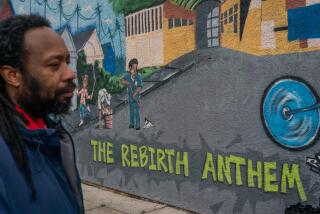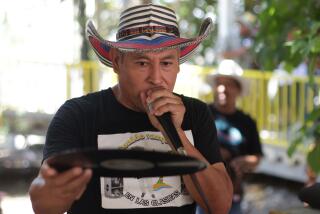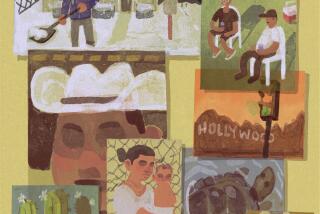A Block That Rests on Sharing : Neighborhood: The residents of Monrovia’s Oakcliff Road keep the street’s friendly spirit alive by doing things together.
- Share via
Just below Monrovia’s canyons runs Oakcliff Road, a bastion of neighborliness and stability.
The Northeast Monrovia cul-de-sac of about 30 homes is known for its block events. In addition to annual New Year’s Eve parties, residents each March hold a back-yard sale, where anything from plastic kitchenware to Art Deco lamps can be picked up at bargain prices.
“Often,” chuckled Charlotte Schamadan, 41, “we buy things from each other that we put up for sale ourselves a year or two later.”
Schamadan and her husband, Lee, run a graphics design business from their home and create posters for civic festivities.
“We’re the newcomers on the street,” she said. “We’ve lived here only 11 years.”
Queen Esther and Willie Hawkins moved to Oakcliff Road in 1970. “We bought the house because we liked it. We especially liked the kitchen and the three bathrooms,” Queen Esther Hawkins said.
Jane Course, 69, who throws holiday coffee parties for the neighbors, said she and her husband, Ben, are among the earliest residents of the street. They moved there in 1958. Soon after, in 1961, came the Piderits, Pete and Betty.
Pete Piderit, 67, a retired IBM executive, is chairman of the Neighborhood Watch. When he isn’t busy tending his hydroponic tomato patch (the tomatoes are planted in ceramic pebbles and watered four times a day), Piderit runs a Monrovia dance group, which meets annually in his light-green stucco home.
Most residents agree they couldn’t afford to buy on the street now. The ranch-style homes, predominantly three-bedroom-and-den, sell for upward of $300,000.
Oakcliff Road was once in the apron of a lush forest, where Indians occasionally hunted and fished. It is topped by 5,409-foot Monrovia Peak, and grooving southward along rocky creeks and streams are what are known now as Monrovia and Sawpit canyons.
Just below the junction of the two, a deep “saw pit” was once dug. According to legend, Franciscan priests and Indian laborers hauled lumber down the mountain for the construction of the San Gabriel Mission, and crouched together in the pit to saw it. It’s said they also dug mysterious, long tunnels found in Norumbrega Canyon in 1934.
The pit, which has long since disappeared, was there when the earliest settlers arrived in the area. The first known were the Rankins--Hibbard and Polly--who came in 1874 with their four children. They built a cabin in the canyon and earned their living sawing wood in the saw pit.
Later, the cabin was destroyed by fire and flood, and typhoid fever claimed three of their children. The triple tombstones remain at the top of Canyon Boulevard, Monrovia Historical Society President Steve Baker said. However, after an incident of vandalism about two years ago, the grave markers were restored and permanently placed to lie flat, he said.
After the city of Monrovia was established in 1886, a reservoir was built in Sawpit Canyon. William N. Monroe, of Scott County, Ind., a Civil War cavalry scout and railroad entrepreneur who is considered Monrovia’s founding father, secured the water rights to the two canyons as one of his first official acts as mayor. Later, he built a burro trail up the canyon to what is now Deer Park.
In 1905, Ben Overturff of Selma, Iowa, stumbled upon Deer Park while on a hunting trip, and fell in love with the idyllic glen. Toting supplies, burro-style, up the trial, he built Deer Park Lodge, where, it is said, guests would arrive to find beans on the stove and Mrs. Overturff’s lemon pies on the table.
Sawpit Canyon saw many changes over the years--mainly the construction of Sawpit Dam in 1928 and ’29. In the 1930s, Civilian Conservation Corps workers extended Sawpit Canyon Road to link up with fire roads around Monrovia Peak.
Today, the 13-square-mile city of Monrovia has about 35,000 residents.
Even though crime in the city has gone up in recent years, the people on Oakcliff Road say they feel safe on the street. Many look for signs that someone’s out of town, and then keep a watchful eye on the house.
“I like the quiet, the mountain backdrop and the small-town atmosphere here,” Jane Course said.
Charlotte Schamadan added: “The neighbors are wonderful. And Monrovia is the best-kept secret in the San Gabriel Valley.”
CLOSE--UP, NORTHEAST MONROVIA / Los Angeles Times Population Total: (1990 est.) 10,561 1980-90 change: +7.2% Median Age: 35
Racial/ethnic mix: Latino: 9.7% Black: 1.1% Other: (including Asians) 6.0%
White (non-Latino): 83.2% Income Per capita: $20,078 Average household: $50,726
Median household: $45,423 Income Distribution: More than $150,000: 1.9% $100,000-$149,999: 6.6% $75,000-$99,999: 10.4% $50,000-$74,999: 23.1% $40,000-$49,999: 17.3% $25,000-$39,999: 17.9% Less than $25,000: 22.7%
More to Read
Sign up for Essential California
The most important California stories and recommendations in your inbox every morning.
You may occasionally receive promotional content from the Los Angeles Times.






